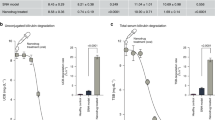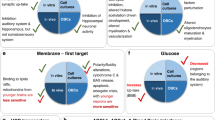Abstract
Extract: A patient with type I congenital nonhemolytic jaundice (type I Crigler-Najjar syndrome (CNJ)), who first developed overt neurologic signs at age 18, is reported. Studies with isotopic bilirubin, performed both when she was well and after the onset of brain damage, demonstrated normal hepatic bilirubin uptake and storage capacity, and normal bilirubin turnover (3.0 mg/kg/24hr). As a result of a virtual absence of conjugation, net bilirubin clearance was reduced to 0.0075 ml/min/kg, which is approximately 1% of normal (0.65 ± 0.18 ml/min/kg). Therapy with glutethimide, phenobarbital, blue light, and oral agar were all ineffective in reducing the concentration of unconjugated bilirubin in plasma or accelerating radiobilirubin disappearance.
The acute onset of neurologic disease occurred at age 18, and may possibly have related to a transient increase in the molar bilirubin to albumin ratio to a value greater than 1.0. Exchange plasmapheresis, performed with a continuous flow centrifuge, rapidly reduced the bilirubin concentration in plasma from 41 to 6 mg/100 ml, and was associated with apparent clinical improvement. A total of 1,900 mg bilirubin was removed by this procedure.
Although in vivo phototherapy was ineffective, in vitro illumination of the patient's plasma with special blue lamps produced a rapid fall in the bilirubin concentration in plasma. Bilirubin was converted to polar, diazo-negative derivatives by a process in which several steps could be distinguished. The initial photodegradation products were colored, tightly albumin bound and nondialyzable, which explained their tendency to be excreted in the bile in preference to the urine. Continued illumination for up to 24 hr resulted in the production of colorless, nonalbumin-bound compounds which, when injected into rats, were excreted principally in the urine.
Speculation: Pending the perfection of techniques for auxiliary hepatic transplantation in man, extracorporeal phototherapy or hemoperfusion over albumin-conjugated agarose columns may provide a means of prevention of the otherwise inevitable development of neurologic disease in patients with type I CNJ.
Similar content being viewed by others
Log in or create a free account to read this content
Gain free access to this article, as well as selected content from this journal and more on nature.com
or
Author information
Authors and Affiliations
Rights and permissions
About this article
Cite this article
Blaschke, T., Berk, P., Scharschmidt, B. et al. Crigler-Najjar Syndrome: An Unusual Course with Development of Neurologic Damage at Age Eighteen. Pediatr Res 8, 573–590 (1974). https://doi.org/10.1203/00006450-197405000-00006
Issue date:
DOI: https://doi.org/10.1203/00006450-197405000-00006
Keywords
This article is cited by
-
Acute cholangitis in an old patient with Crigler-Najjar syndrome type II - a case report
BMC Gastroenterology (2016)
-
Inherited disorders of bilirubin clearance
Pediatric Research (2016)
-
Crigler-Najjar syndrome type II
Digestive Diseases and Sciences (1995)
-
Hepatic transport and metabolism of various organic anions in patients with congentital non-hemolytic hyperbilirubinemia, including constitutional indocyanine green excretory defect
Journal of Gastroenterology (1994)
-
Interrelationships of liver and brain with special reference to reye syndrome
Journal of Inherited Metabolic Disease (1991)



